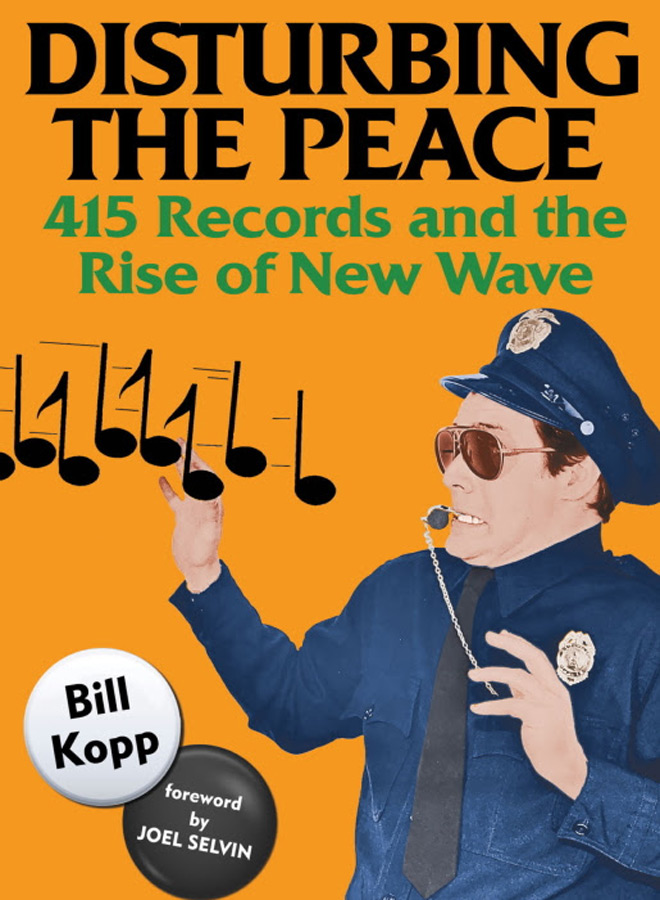Nostalgia can be a powerful thing, and nostalgia for some eras can be stronger than others. For example, it feels like 1980s nostalgia has lasted longer than the actual decade. Sure, there will be the odd bit of media that tries to capture 1960s doo-wop, 1970s muttonchops, or 1990s attitude. But just a splash of neon pink, electric blue, and thrumming synth can be enough to wash all that away with glowing memories of Steven Spielberg films, Patrick Nagel paintings, and New Wave music.
Which leads into the latest book from Author Bill Kopp (Reinventing Pink Floyd 2019) and HoZac Books. Disturbing the Peace: 415 Records and the Rise of New Wave details the founding of the San Francisco indie record label 415 Records, and its influence on other labels and sounds. It goes from its creation by area DJ Howie Klein and Chris Knab, to a variety of stories involving the likes of Romeo Void, Wire Train, Roky Erickson and many other bands that called 415 Records their home.
The book will be out February 14, 2022, and comes complete with a foreword by Music Journalist Joel Selvin. It aims not just to detail the establishment of a music label, but to capture that cultural shift into punk & New Wave within San Fran and beyond. Does it manage that though?
It tells 415 Records’ story across 362 pages, with up to 300 color and black & white images. The book is then split into four parts; Disturbing the Peace: 415 Records and the Rise of New Wave covers the history of Klein and Knab up to the label’s founding, ‘The Indie Years’ talks about its time as an independent label, ‘The Columbia Era’ goes into its time under Columbia, before ‘A Temporary Thing’ closes it off with 415 Records’ legacy.
The chapters play out similarly to Ska-Boom! An American Ska and Reggae Oral History by Marc Wasserman, with each one following a different band. Except they go into the band’s releases, like The Nuns EP in 1978, or Pop-O-Pies’ The White EP in 1981, with the odd historical chapter here and there (the one covering the signing with Columbia is called “The Worst Label of All”).
They make for fairly brief reads too, with the longest chapters being up to ten pages long, and the shortest being about two. Though it does not feel like anything important has been left out. Kopp’s approach would bring the time to life. He manages it without going into extraneous details too, just the important nitty-gritty behind each band, release and event. Any extra bits come off less like fluff and more like nice asides or sprinkles of trivia (Klein’s photography for Harvey Milk, etc).
The same goes for the book’s use of photos. They pepper the chapters here and there, with set lists, key documents, concert posters, buttons and more. They make for some nice flourishes that help pull the reader into its world and visualize the shifting tastes of the early 1980s.
The book shows a keen interest in its subject matter, and does not come off like a dry textbook just chronicling a record label. Even so, it might be an acquired taste for people outside of the genre or the Bay Area. In that they may get pulled in by Kopp’s writing to check out more from Translator or The Offs, etc. They just have to give the book a chance first, and indie San Fran New Wave is more likely to appeal to those big into music or those genres. Casuals and people outside of New Wave might need more convincing.
That said, for what it is, Disturbing the Peace: 415 Records and the Rise of New Wave is a strong, tightly-written book that brings the heyday of 415 Records to life. The label’s mission statement was to be a fun place to produce music for than focusing on profit and, through the ups and downs, Kopp really brings that out in his writing. For those in the know, it is a must-read. For anyone else, as niche as it may be, it is worth one’s while. Thus, for these reasons, Cryptic Rock gives Disturbing the Peace: 415 Records and the Rise of New Wave 4 out of 5 stars.






No comment